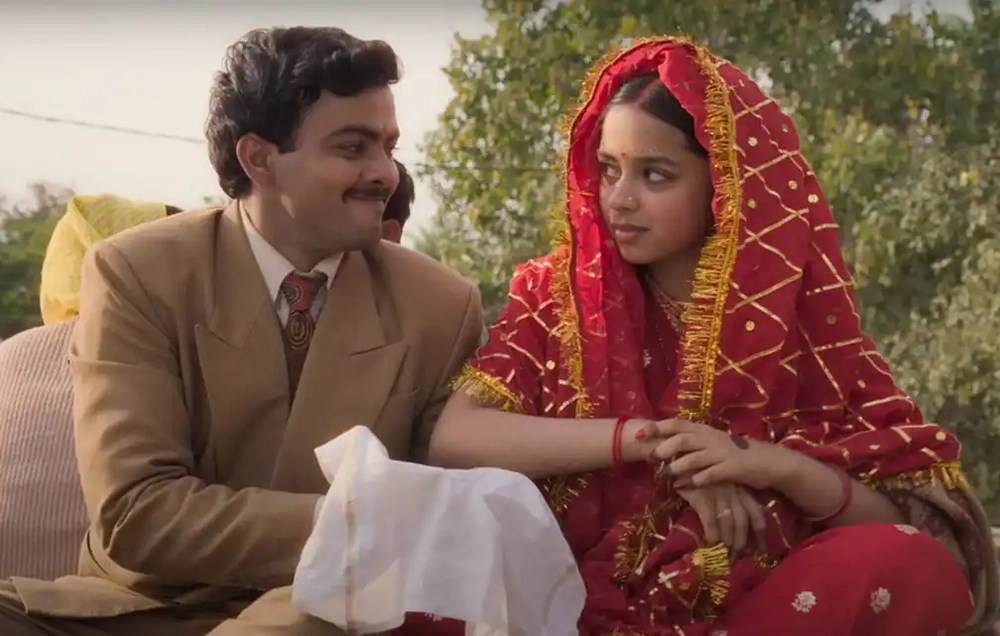In “Laapataa Ladies,” the beginning of the millennium sees a naive, newlywed young lady named Phool (Nitanshi Goel) accompanying her husband Deepak (Sparsh Srivastav) on a long train journey to her in-law’s house. This marks her first step into another man’s household, or rather into another household’s kitchen. While the cloistered Phool is most likely destined to lead a predetermined life as a traditional housewife, fate however intervenes. In his exhausted state, Deepak accidentally alights at his destination with the outspoken and also newlywed Jaya instead.
Waking up at the wrong platform all alone, Phool is left to fend for herself, in the hopes that Deepak will ultimately turn up in search of her much like the proverbial prince out of a fairytale. Meanwhile, Jaya (Pratibha Ranta)—who is no novice to the outdated norms that have set women back for centuries—is determined to not lose out on the opportunity of a lifetime. She basks in the glow of her newfound status as a ‘Laapataa’ (missing) lady; she perceives the mix-up as a stepping stone to achieve the individuality she’s craved for all along.
A Triumphant Return from Kiran Rao
The film is directed by Kiran Rao, who returns behind the camera 13 years after her critically acclaimed debut film “Dhobi Ghat.” It’s accompanied by a screenplay and dialogues by Biplab Goswami, Sneha Desai, and Divyanidhi Sharma. “Laapataa Ladies” is unrestrained in its takedown of patriarchal practices. At times it directly addresses the issue via the inclusion of strong, independent and downright cool female supporting characters, which adds to its flare. We see Manju (Chhaya Kadam), who runs a tea stall at the railway station, who advises the gullible Phool to exercise her free will, simultaneously opening her eyes to the hurdles for women before her that are a direct result of patriarchy.
However, at other times, the film makes its points via an indirect approach, slipping in clever motifs such as the bridal veil bearing down upon a newly married woman that not only blinds her but silences her to the omnipresent patriarchal conditioning and power imbalance between sexes. The film equates this traditional ornament to snatched identities (in another scene, the veil is also replaced by a burqa, indicating that this is commonplace in most other religions too). Even an amusing running gag of Manju firmly laying down the law when it comes to an overindulgent male customer’s chutney intake highlight’s women taking back their agency or drawing boundaries. Earlier, a brief glimpse of a frightened Phool cowering behind a bin at the station serves as an unfortunate polar opposite and an indication of patriarchal society’s treatment of women as disposable and even invisible.
Addressing Patriarchy Through Empowerment

The film’s motifs also lend to the layered characterisation of both the brides. Jaya’s tattoo of her own name emblazoned across her wrist symbolizes her individuality. On the contrary, Phool—who has been conditioned to not even address her husband by his first name, lest it bring ill fortune—is viewed as a ‘belonging’ and thus marked by her husband’s name on her palms in henna. And in another pertinent scene, Phool is introduced to the concept of a carefree existence without a man by Manju, who is the sole woman of the house. Here, one can catch a glimpse of a garlanded portrait of Dr. Bhimrao Ambedkar—a revered advocate for human rights and for the oppressed Dalit community at the latter’s humble abode. It amplifies the need for more such male role models who can contribute greatly to women’s rights and equality.
Furthermore, the movie is allegorical in its messaging, with comparisons drawn to women being as interchangeable as city names in a seemingly developing country. At the same time, it also hints at the sinister undertones of a missing woman being entirely erased from existence, quite literally. However, “Laapataa Ladies” is also infused with a lighter and more hopeful message. It acts as a lesson on how women can support fellow woman’s choices and lifestyle. This results in progress in the long run, but also in loosening up the in-built tension and lessening the generational gap amongst women in joint households. They can learn to open up to each other, co-exist and thus break bread, as well as mould together.
A Pitch-Perfect ‘Girl Power’ Movie
There are also plenty of subversions as the movie progresses, with scenes of the spunky Jaya using her veil to evade capture by the policemen hot on her heels and nosy in-laws. Meanwhile Phool—who has been conditioned to run a home by herself to keep her husband content—also begins to channel her skills in the kitchen to earn her keep. She learns to survive on her own; and in the process, she lean towards a life of self-sustenance.
Both leading ladies Nitanshi Goel and Pratibha Ranta excel at playing their respective roles with sincerity. Ravi Kishan is not far behind as Inspector Manohar, a local cop who is suave and prone to bribery and power trips. Yet he’s not entirely irredeemable nor lacking in empathy either. Chhaya Kadam is a natural at holding one’s attention as the stern, strong-willed Manju, who turns out to be instrumental in Phool’s character arc. Satendra Soni as Chhotu (a hardworking and kind man who suffers from dwarfism and ekes out a living at Manju’s stall)—as well as Sparsh Shrivastav and Daood Hussain as Deepak and the gentlemanly Gunjan—leave impressions in their supporting roles. Ram Sampath’s melodic compositions—especially the love theme “Sajni”—lend to the endearing energy, particularly the enthralling final act. Viewers are treated to the second most wholesome reunion at a railway station since “Slumdog Millionaire.”
Ultimately,” Laapataa Ladies” is a pitch-perfect girl-power movie, as well as a much-needed wake-up call on weeding out toxic elements such as entitlement and misogyny. With an endless rewatch value to boot, make sure to reserve your seats aboard this anti-patriarchy train.
“Laapataa Ladies” is available to stream on Netflix subscription.